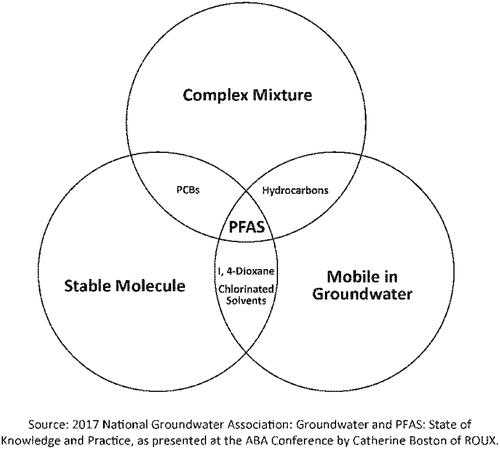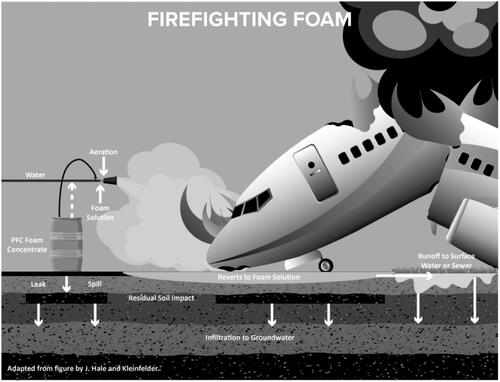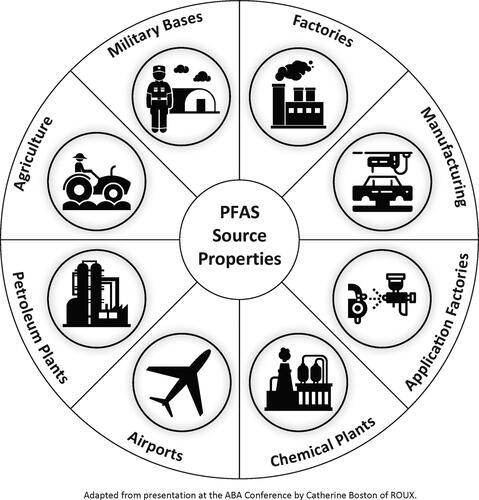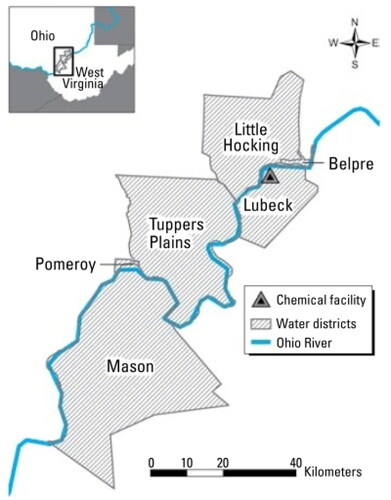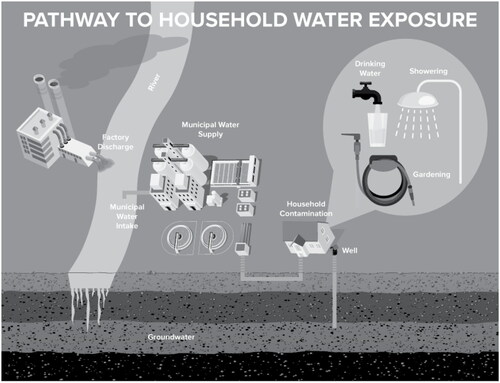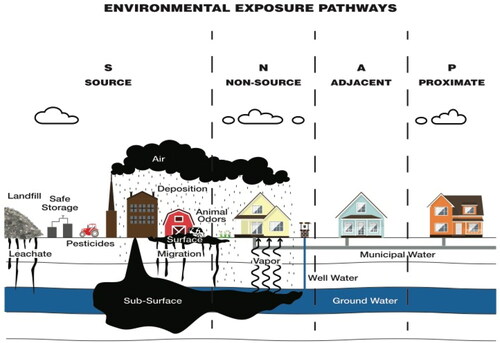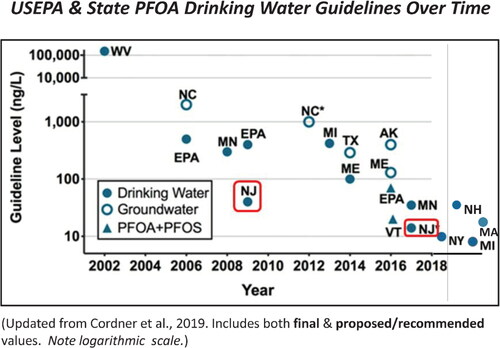Abstract
The so-called “Forever Chemicals,” i.e. PFAS or PFCs, are emerging environmental contaminants. They refer to a family of carbon-fluorine chemicals that were initially developed in the commercial and industrial sectors around the time of WWII. As the term PFAS is a catch-all, there are many individual compounds, including C8, PFOA, PFOS, AFFF, PFNA, PFHxS, and GenX. Until the late 1990s/early 2000s, the health risks of PFAS compounds were largely unknown to the general public. But with the increasing ability to detect and monitor these compounds in humans and the environment, information is now more widely available. Health advisories are being developed at federal and state levels as to the adverse human health effects associated with PFAS are becoming clearer. As public awareness and the ability to detect PFAS compounds evolve, so must real estate valuations. Real estate valuation professionals are facing assignments that require an evaluation of the impact, if any, of PFAS on property values, in particular, properties with tainted household water. This article outlines the fundamental characteristics of PFAS compounds and sets forth valuation methodologies, such as mass appraisal methodologies, that can be used to determine the impact, if any, PFAS have on real estate values. Appraisal literature and textbooks have established the use of regression for mass appraisal assignments. The profession has also developed numerous well-accepted methodologies that can also be used to address mass appraisal assignments. This article addresses the use of regression as a real estate valuation methodology, the use of sale/resale as a mass appraisal technique, and the use of a case study approach in environmental contamination assignments related to PFAS.
Forever chemicals
Perfluorocarbons, sometimes also referred to as per- and polyfluoroalkyl substances (PFAS), are a family of man-madeFootnote1 long- and short-chained synthetic chemicals with a carbon-fluorine bond.Footnote2 As the term PFAS is a catch-all, there are many individual compounds, including C8, PFOA, PFOS, AFFF, PFNA, PFHxS, and GenX. Indeed, there are more than 5,000 PFAS compounds produced for commercial and industrial uses.Footnote3 PFAS compounds are notable for their remarkably strong carbon-fluorine bond, which provides a high thermal and chemical stability and prevents their easy breakdown in the natural environment.Footnote4 This renders PFAS both biopersistentFootnote5 and bioaccumulativeFootnote6 in the environment and the human body.Footnote7 These characteristics have earned PFAS the moniker “Forever Chemicals.”
While PFAS compounds are emerging chemicals of concern, similar chemicals of concern share like characteristics ().
History of perfluorocarbon’s
The first PFAS compound, PTFE, was invented in the 1930s,Footnote8 with early production stemming from the days of the Manhattan Project in the 1940s.Footnote9 PFAS compounds were originally used to line military tanks, providing a layer of protection in the field of battle. As World War II came to an end, chemical producers, such as E. I. du Pont de Nemours and Company (DuPont) and 3 M Company (3 M), continued production of FAS compounds by integrating their uses into new products because the compounds were desirable for the stain resistance, stick resistance, durability, and so forth. For example, the first mass-produced consumer product was Teflon-brand coated pans. In the 1960s, 3 M Company and the U.S. Navy created Class B “aqueous film forming foam” (AFFF), which includes PFAS compounds and was used in firefighting ().Footnote10
As the utility of PFAS chemicals became more widely known, and as more PFAS compounds were invented, they were used at numerous commercial and industrial sites throughout the world. For more than 70 years, much of which pre-dated modern environmental laws, PFAS compounds have been used at manufacturing facilities and as a firefighting foam application, resulting in releases into the environment. In the 1990s, public science began detecting PFAS chemicals in human and animal blood serum.Footnote11 Although the use of PFAS was widespread, commercial and industrial users have not, until recently, been required to report their manufacturing, importing, or processing of PFAS chemicals.Footnote12 The lack of governmental oversight for decades has had obvious consequences, including presence of these compounds in the environment.
In 2016, the Toxic Substance Control Act (TSCA) was amended with the addition of the Frank R. Lautenberg Chemical Safety for the 21st Century Act. The amendment added new framework rules to help prioritize, evaluate, and regulate chemicals in the United States. One such rule required industry reporting of chemicals that are manufactured, imported, or processed in the United States over the past 10 years.Footnote13 And in 2015, the EPA proposed a Significant New Use Rule (SNUR) to require manufacturers (including importers) and processors of PFOA and related PFAS chemicals to notify the EPA at least 90 days before starting or resuming new uses of such chemicals in any products.Footnote14
Toxic releases of PAS compounds at these manufacturing and firefighting foam application sites, both historical and contemporary, are an ongoing concern for surrounding property owners. Recent scientific advancements have improved the ability to detect and monitor PFAS compounds in humans and the environment, which has in turn resulted in the discovery of PFAS release sites throughout the world. PFAS manufacturing and processing facilities, facilities using PFAS in production of other products, airports, and military installations have been associated with PFAS releases into the air, soil, and water ().Footnote15
Discovery of PFAS as a hazardous chemical
In 1998, a Parkersburg, West Virginia farmer named Wilbur Earl Tennant reached out to attorney Rob Bilott with concerns over the health of his cattle. Between 1984 and 2001, Mr. Tennant lost approximately 300 cattle due to undetermined health reasons.Footnote16 DuPont owned the property adjacent to Mr. Tennant’s farm and used it as a landfill, in which they dumped PFAS chemicals.Footnote17 After contacting Mr. Bilott, a claim was filed on behalf of Mr. Tennant against DuPont.
Mr. Tennant settled with Dupont in 2001. Around that same time, Lubeck Public Service District, in conjunction with DuPont officials, sent a letter to residents utilizing the municipal water system, warning of the current levels of the PFAS compound, C8, in the municipal water system.Footnote18 Through discovery, Mr. Bilott also received decades worth of files from DuPont, which included scientific studies that measured toxicity and potential hazards to human health and studies performed on mice and primates testing for adverse health effects associated with PFAS exposure. The documents also included studies related to congenital disabilities of children born to women who worked at the DuPont plant in West Virginia.
Using the information gleaned from these documents, Mr. Bilott’s firm, Taft Stettinius & Hollister LLP, Hill Peterson Carper Bee & Deitzler PLLC, and Winter & Johnson, filed another lawsuit in 2001 on behalf of a class people who received household water impacted by the release of C8 from the DuPont Washington Works plant. After filing the lawsuit, the Wood County Circuit Court in West Virginia approved a class settlement in February 2005, which included a medical investigation paid for by DuPont.Footnote19 The investigation sought to study human health concerns surrounding PFAS compounds. The settlement culminated in the largest epidemiological study in human history, known as the C8 Health Project Study of Environmentally Exposed Communities in the Ohio River Valley Area. Residents of six water districts, including Lubeck Public Service District, City of Belpre, Tuppers Plains-Chester Water District, Village of Pomeroy, Little Hocking Water Association, and Mason County Public Service District, were considered class members.Footnote20 The following figure depicts the class geographical area ().
The study sought to determine if exposure to PFAS compounds is linked to any human health disease.Footnote21 Footnote22 After approximately seven years of analysis that involved roughly 69,000 blood samples and interviews with residents in the class area, the results of the study linked PFAS exposure to six human health issues: ulcerative colitis, thyroid disease, testicular cancer, kidney cancer, pregnancy-induced hypertension, and increased cholesterol.Footnote23
Environmental exposure pathways
In order for there to be a risk of adverse health effects associated with PFAS compounds, there must be a clear exposure pathway,Footnote24 sometimes also referred to as “bioavailability,” which is the extent to which a contaminant becomes available to humans or the plants and animals of a region.Footnote25 The predominant PFAS exposure pathway currently being studied is household water ().
In addition to household water, there are six other media that can be contaminated: air, water, building improvements, surface/shallow soils, groundwater aquifers, and deep soils.Footnote26 Within each, there are numerous potential pathways of exposure that relate to real estate, including air, vapor intrusion, topsoil, surface, sub-surface, well water, municipal water, surface water, particulate deposition, and many more. These subcategories can be grouped into three general categories: air, surface, and subsurface.Footnote27
Pathways to exposure for real estate
The relationship between real estate and contaminants can also be described through a SNAP analysis, which denotes Source, Non-source, Adjacent, and Proximate. Source sites are those on which contamination is, or has been, generated. Non-source sites are those onto which the contamination, generated from a Source site, has migrated. An Adjacent site is not contaminated, but shares a common property line with a Source site. Proximate sites are not contaminated and not adjacent to a Source site, but are in close proximity to the Source site.Footnote28 illustrates the SNAP analysis and different pathways to exposure.
PFAS regulation
Remediation and mitigation efforts can be implemented to limit environmental exposure pathways. However, PFAS compounds pose unique environmental engineering challenges and many conventional treatment technologies are ineffective.Footnote29 PFAS remediation and mitigation technology is being tested and in some cases mitigation technology is being implemented to limit water and soil exposure.Footnote30 Some examples include granulated activated carbon, ion exchange, and reverse osmosis, for water.Footnote31 Excavation, sorption and stabilization (immobilization), and incineration, for soil.Footnote32 Strategies regarding the implementation of these technologies are under development.
While the remediation and mitigation technology that is being tested may help minimize soil and water exposure, it does not address every potential environmental exposure pathway. Additional treatment technology will be needed, and it can evolve over time.
Furthermore, the United States Environmental Protection Agency (EPA) has yet to establish an enforceable regulatory level, or Maximum Contaminant Levels (MCLs), for PFAS drinking water standards.Footnote33 It has only promulgated health advisories (HAs) for PFOA and PFOS.Footnote34 The current PFOA and PFOS drinking water HA set forth by the EPA is less than 70 parts per trillion (ppt).Footnote35 The EPA initially set forth an HA in 2009 of 400 ppt for PFOA and 200 ppt for PFOS, but as science evolved, the EPA lowered the HA to its current levels in 2016 to account for the health risks associated with PFAS exposure.Footnote36 While the EPA has yet to establish an enforceable limit for PFAS compounds, they have made a final determination to set drinking water limits PFOA and PFOS in the coming years;Footnote37 however, some state agencies have already established advisories for PFAS compounds, and in many cases, at lower thresholds than the EPAs current HA levels.
For example, Vermont lowered their drinking water HA to 20 ppt for PFOA, PFOS, PFNA, PFHxS, and PFHpA.Footnote38 In addition, the State of New Hampshire has passed enforceable maximum contaminant levels (MCLs) for several PFAS compounds in drinking water. The MCLs include 12 ppt for PFOA, 15 ppt for PFOS, 11 ppt for PFNA, and 18 ppt for PFHxS. Other states that have established HAs or MCLs (or an equivalent water standard) including New Jersey, Massachusetts, Michigan, New York, Pennsylvania, Washington, Alaska, California, Connecticut, Maine, Minnesota, North Carolina, and Rhode Island.Footnote39 The overall trend in regulatory levels is downward. Indeed, California’s Office of Environmental Health Hazard Assessment (OEHHA) recommends establishing notification levels (NLs) at the lowest level that can be reliably detected in drinking water using currently available and appropriate technologies.Footnote40 Some states, like New Jersey, have gone so far as to establish PFAS monitoring requirements for drinking water and treatment measures should testing exceed the state MCL ().Footnote41
The downward trend in state and federal PFAS guidelines and regulations adds to the overall uncertainty and lack of awareness surrounding PFAS issues perceived by participants in the real estate marketplace. This is exacerbated by the fact that the regulations have addressed only a few of the thousands of PFAS compounds. Many advisories do not address the numerous PFAS compounds still in production today, even though the EPA identifies those compounds as posing a health risk.Footnote42
Real estate damage methodologies
There are numerous methodologies that real estate appraisers can use to determine the impact, if any, of PFAS contamination on the value of real estate. The Appraisal of Real Estate, 15th Edition, under the section “Contamination and Environmental Risk Issues,” outlines the use of paired sales, case studies, multiple regression, and adjustments of income and yield capitalization rates on income-producing properties.Footnote43 In addition to those methodologies, an appraiser can consider using sale/resale, simple regression, market surveys, literature review, foreclosure rates, sales volume, days on market, listing discounts, mortgage rate adjustments, insurance adjustments, project delay, and other methods.Footnote44
When engaging in assignments, appraisers are often asked to determine the value or diminution in value of a single property, but this is not always the case. It is becoming more common that an appraiser is asked to study a group of properties or conduct a mass appraisal. With the widespread historical use of PFAS compounds, contamination effects are being discovered across groups of properties such as neighborhoods, communities, towns, and cities. As a result, real estate valuation professionals may be asked to study the impact of PFAS, if any, on the value of a mass group of properties. How can such a mass valuation be performed?
Regression
Valuing mass groups of properties with regression analysis is seen in class action litigation assignments, market condition assignments, the sales comparison approach,Footnote45 water view studies,Footnote46 Superfund proximity studies,Footnote47 estimating equilibrium vacancy,Footnote48 impact of express rail links,Footnote49 forecasting commercial real estate appreciation,Footnote50 impacts of high voltage transmission lines,Footnote51 impacts of historic façade easements,Footnote52 and in other instances. In environmental contamination class action cases, such as those involving PFAS contamination, “reasonable similarities in property, market, and environmental characteristics, property interests defined in a class action can be meaningfully analyzed”Footnote53 using regression analysis.
Under The Appraisal of Real Estate’s 15th Edition section “Regression Analysis,” the text also states that “it is not uncommon to include an environmental variable or variables when investigating the effect of an external environmental factor.”Footnote54 Multiple regression analysis has been frequently used in the estimation of residential property values and environmental impacts on residential properties;Footnote55 more recently multiple regression has been used to study the sale price and capitalization rates of environmentally contaminated commercial properties.Footnote56 Statistical techniques such as regressions provide useful tools when studying groups of properties (or a class), as they are engineered to produce a variety of designs and outputs including, (1) aggregate results, (2) an output that allows damage calculations on a property-by-property basis, or (3) outputs that allow damage calculation on a zone-by-zone or neighborhood-by-neighborhood basis. Also, in a class action lawsuit, a regression model can utilize subclasses, although not necessary.
Valuing groups of properties may also be referred to as mass appraisal. To accommodate these types of assignments, Uniform Standards of Professional Appraisal Practice (USPAP) established Standards 5 and 6. The appraisal profession has also aided in the progression of mass appraisal assignments by requiring statistical analysis as part of the certified general license qualifying education, and the Appraisal Institute has developed statistical course requirements to obtain the MAI designation, which states “a regression can be used to form the basis for an opinion of value by direct sales comparison approach.”Footnote57
In addition, Chapter 14, “Statistical Analysis,” in The Appraisal of Real Estate, 15th Edition, is dedicated to the use of statistical methodology that can be used in a mass appraisal assignment. Indeed, “traditional appraisal techniques have been steeped in statistical analysis.”Footnote58 Furthermore, the professional text states that “statistical techniques like regression analysis have become accepted tools in the application of the approaches to value.”Footnote59 When properly developed, the appraisal profession accepts the utilization of regression in mass appraisal assignments and to measure the effects, if any, of detrimental conditions like PFAS on property values.
Sale/resale
While regressions can provide useful tools to studying environmental effects on groups of properties, it is not the only tool that appraisers can use; there are numerous additional appraisal methodologies that, when employed properly, can be used to determine real estate damages on a mass basis. For example, a sale/resale analysis is used as a mass technique to produce many real estate market price indices, such as those provided by the Federal Reserve Economic Data (FRED), which includes the S&P CoreLogic Case-Shiller Home Price Indices.Footnote60 The use of the sale/resale technique in the construction of indices dates back to 1963 as an extension of statistical regression techniques.Footnote61 Although the idea was presented more than 50 years ago, it did not receive significant attention until work by Case and Shiller in 1987,Footnote62 1989,Footnote63 and 1990.Footnote64 The sale/resale technique plays an important role in the housing research communityFootnote65 and is an important tool that appraisers can use in mass appraisal assignments.
A sale/resale analysis has been characterized as an alternative to hedonic regression models when determining the effect of environmental contamination on property values.Footnote66 In developing a sale/resale model to measure environmental effects on property values, certain considerations should be made:
“[T]here has been a change in environmental quality of the properties that are studied and that this change not be uniform among the properties.”Footnote67 This is the foundation of an environmental sale/resale analysis, where properties without environmental contamination are compared to the subsequent resale or prior sale of the same property with environmental contamination and adjusted for any market changes overtime;
“[A] significant number of properties must have sold at least twice, a requirement which is not restrictive in neighborhoods of younger families.”Footnote68 However, the effects of environmental contamination may slow markets and significant sales data may be limited. This does not prevent an appraiser from performing a sale/resale analysis with the data that is available and considering the results in a mass appraisal assignment;
“[T]he characteristics of houses other than age and environmental quality must not have changed significantly between sales, or the data must be screened to eliminate properties where there have been significant changes.”Footnote69 Even when changes occur, appraisers can consider other adjustments much like the traditional sales comparison approach.
A defining aspect in many real estate damage assignments is comparing the sale of a property without a detrimental condition (unimpaired) to the sale of a property or group of properties with a detrimental condition (impaired). The first consideration of a sale/resale analysis establishes this foundation.
With emerging contaminants, such as PFAS compounds, market awareness plays an important role in the analysis. A similar rule applies when using multiple regression, where substantial public knowledge of the environmental incident is required to effectively measure risk effects.Footnote70 When using a sale/resale analysis to measure risk effects, public knowledge or individual transaction knowledge of the environmental condition should be considered. For example, when analyzing the resale of a property, with contamination, an appraiser should ensure that the participants of the transaction are aware of the contamination issue that effects that property. This is often performed through a confirmation process, which may include verifications with transaction participants, analysis of real estate disclosure documents, public notices, and others. When the study area of an assignment lacks market awareness of the detrimental condition being studied, other appraisal techniques, such as a case study approach, can serve as a valuable tool.
Environmental case studies
A case study approach can be advantageous when there is a lack of direct market data or where analyses of direct market data need additional support.Footnote71 For example, a town with PFAS drinking water contamination (the subject area) may lack transactional data, or the subject area market participants may be unaware, uninformed, misinformed, or partially informed about the detrimental PFAS household water contamination issue. In that case, a case study approach enables an appraiser to study an otherwise similar situation with informed market data and draw on those findings to develop opinions about the subject area. Since PFAS compounds are emerging contaminants, contaminated areas may lack market awareness; in these instances, a case study approach is a valuable appraisal technique.
Knowledge is a critical element in economics. The real estate market and other markets are profoundly impacted by the level of knowledge held by the individual buyers and sellers. Indeed, a fundamental aspect of appraisal is the definition of “market value,” which is premised on a knowledgeable buyer and seller, and is defined as follows:
The most probable price, as of a specified date, in cash, or in terms equivalent to cash, or in other precisely revealed terms, for which the specified property rights should sell after reasonable exposure in a competitive market under all conditions requisite to a fair sale, with the buyer and seller each acting prudently, knowledgeably, and for self-interest, and assuming that neither is under undue duress.Footnote72
By definition, market value mandates that both buyers and sellers are acting knowledgeably. If the market or individual buyers are uninformed, partially informed, or misinformed, then that impaired knowledge can affect the appraisal process. There are some well-known illustrations of these principles. For example, if properties are sold where the sellers lack knowledge that the site holds significant mineral rights and oil reserves, then the sales price may not reflect its actual market value. This property could be worth significantly more with the knowledge of the mineral rights.
Similarly, if the property is sold where the buyer is uninformed, partially informed or misinformed about a material latent defect, such as it being within a flood zone, then the sales price may not reconcile with the actual market value where a buyer is fully informed of potential flood risks. Simply, if a buyer is uninformed, then the sales data may not reflect the impact of the actual market value. Whereas, when the buyer and seller are well-informed, then the effects, if any, of a detrimental condition would typically be reflected in the transactional market data. Case studies enable an appraiser to study the effects of detrimental conditions, despite a lack of market awareness in a subject area, rather than limiting an appraiser’s ability to study a detrimental conditions impact, if any, on property value.
With emerging contaminants, such as PFAS compounds, a lack of market awareness may occur for many different reasons, such as changes in regulatory guidance. For example, if a state establishes new and lower regulatory levels, prior property transactions would likely not reflect the perceived risks and uncertainties of the real estate market participants under the new regulatory levels because they were not considered “contaminated” under the prior guidance. With emerging contaminants, another example occurs when there is a lack of disclosure because testing is still underway. As a result, a seller may not know that their property is “contaminated,” and disclosure of the contamination may not occur. Although market participants may not be aware of the property-specific contamination issues, an appraiser may later be provided with scientific evidence and must account for this knowledge in an assignment.
When applying the results of environmental case studies, an appraiser should consider whether the case studies are similarly situated with respect to the subject property(ies) and environmental condition.Footnote73 However, when performing a case study, the similarly situated property(ies) do not need to be in the same area as the subject property(ies). Data limitations usually necessitate searching a broad geographical area.Footnote74 In case studies and mass appraisals, things do not have to be identical or similar; it’s rare, if not impossible, to find identical case studies. The objective is to find case studies that are similar on some meaningful level.
Drawing on the use of market grids in the sales comparison approach, a case study grid can be developed to draw comparisons between the subject property(ies) and case studies.Footnote75 With environmental case studies, USPAP Advisory Opinion 9 outlines ten relevant environmental contamination property characteristics that can be used in the development of an environmental case study grid. These characteristics are:
whether the contamination discharge was accidental or permitted;
the status of the property with respect to regulatory compliance requirements;
the remediation lifecycle stage (before, during or after cleanup) of the property as of the appraisal date;
the contamination constituents (petroleum, hydrocarbons, chlorinated solvents, etc.);
the contamination conveyance (air, groundwater, soil, etc.);
whether the property is a Source, Non-Source, Adjacent, or Proximate site;
the cost and timing of any remediation plans;
liabilities and potential liabilities for site cleanup;
potential limitations on the use of the property due to the contamination and its remediation; and
potential or actual off-site migration (from the Source site).Footnote76
Since some of these environmental characteristics require scientific expertise, and an appraiser is usually not an expert in the scientific aspects of contamination, experts from other fields will typically provide the necessary informationFootnote77 or environmental materials such as Phase II reports or soil, water, or air test results may be provided. For assignments involving PFAS contaminants, it is an appraiser’s job to value the real estate and the impact of PFAS contaminants on the value of a property or class of properties. It is not an appraiser’s professional responsibility to opine on science or health impacts of PFAS contaminants.
An appraiser should also consider the use of extraordinary assumptions when information regarding environmental characteristics serves as a basis for an opinion of value.Footnote78 For example, if certain subject properties are impacted by PFAS contaminants, an assumption should be made regarding the presence of PFAS compounds with reference to the source of such information.
Conclusion
PFAS compounds are an emerging environmental contaminant that present a challenge to the valuation profession as both public knowledge and environmental regulations evolve. Household water and other environmental pathways can present potential health risks to property owners and tenants, which may result in questions related to real estate damages or diminution in value.
The ability to detect and monitor PFAS compounds in humans and the environment is making information more widely available. But in communities with PFAS contamination where there is little or no market awareness of the issue, a case study analysis can be considered to determine impacts, if any, to real estate value.
PFAS compounds can impact vast neighborhoods or regions, and thus it may be necessary to employ mass appraisal techniques. Such techniques could include paired sales, case studies, multiple regression,Footnote79 sale/resale, simple regression, market surveys, literature review, foreclosure rates, sales volume, days on market, listing discounts, mortgage rate adjustments, insurance adjustments, project delay, and other methods.Footnote80 For income-producing properties, a study of income and yield capitalization rates can be conducted.Footnote81 When possible, real estate valuation professionals may consider employing more than one mass appraisal technique to determine the impact, if any, of environmental issues on property values. This allows for reconciliation of the data across the different approaches; however, utilizing one approach can still allow for reconciliation because a real estate valuation professional can employ one approach with numerous points of data and those points of data can be reconciled when producing an opinion of value.
Parkersburg, West Virginia was one of the first sites where significant awareness of the impact of PFAS was studied. Since then, concerns over PFAS compounds have sparked investigations into numerous potential releases around the world. Like Parkersburg, human exposure through household water is an ongoing concern. In the United States, state water boards and health departments are testing public drinking water systems around manufacturing and military sites. The Environmental Working Group (EWG) and Social Science Environmental Health Research Institute at Northeastern University (SSEHRI) have established and mapped PFAS testing sites across the United States. As of January 2021, more than 2,300 PFAS sites have been identified in 49 states.Footnote82 Sources such as these can be used by real estate valuation professionals to identify areas potentially impacted by PFAS compounds, which may serve as a resource in a valuation assignment.
Additional information
Notes on contributors
Randall Bell
Randall Bell, PhD, MAI, is the author of Real Estate Damages, 3rd Edition, which is published by the Appraisal Institute. He specializes in damage economics and valuation, including environmental, geotechnical, construction defects, natural disasters and eminent domain issues. He has testified as an expert in multiple courts. Dr. Bell founded the Landmark Research Group, LLC and led the real estate damages practice at PricewaterhouseCoopers. Bell consulted on the World Trade Center; the Flight 93 crash site; Hurricane Katrina; the BP oil spill; the Bikini Atoll nuclear test sites; the Sargent Yokoi cave in Guam; the San Bruno pipeline explosion; the Anniston, Alabama spill; the Heaven’s Gate mansion; the Canadian Government UXO site; the O. J. Simpson crime scene; and many others. His career has been profiled widely, ranging from The Wall Street Journal to People magazine, Rolling Stone and every major television network.
Michael Tachovsky
Michael Tachovsky is a principal partner at Landmark Research Group, LLC, a Certified General Real Estate Appraiser and PhD candidate who specializes in real estate damage valuation; this includes environmental contamination, natural disasters, eminent domain, crime scenes, construction defects, and other conditions involving a wide variety of property types. His professional experience includes complex valuation and diminution-in-value studies; including damage issues for government agencies, major corporations, oil and utility companies, developers, and property owners. He has researched disasters such as the Sandy Hook shooting, Uravan Colorado radioactive Superfund site, Chernobyl, and the Love Canal. He has been featured in Forbes and presented real estate damage seminars for Appraisal Institute chapters, the Urban Land Institute, and tax assessors.
Notes
1 T.J. Wallington, M.D. Hurley, J. Xai, D.J Wuebbles, S. Sillman, A. Ito, J.E. Penner, D.A. Ellis, J. Martin, S.A. Mabury, O.J. Nielsen, and M.P. Sulbaek Anderson “Formation of C7F15COOH (PFOA) and Other Perfluorocaboxylic Acids during the Atmospheric Oxidation of 8:2 Fluorotelomer Alcohol,” Environmental Science Technology (2006): 924–930.
2 US EPA, “Drinking Water Health Advisory for Perfluorooctanoic Acid (PFOA),” May 2016, 9.
3 US FDA, “Per and Polyfluoroalkyl Substances (PFAS),” October 31, 2019, https://www.fda.gov/food/chemicals/and-polyfluoroalkyl-substances-pfas.
4 “PEATT Pilot Project Final Report April 29, 2019,” accessed December 5, 2019, https://www.health.pa.gov/topics/Documents/Environmental%20Health/PEATT%20Pilot%20Project%20Final%20Report%20April%2029%202019.pdf.
5 Biopersistance meaning that it does not break down easily.
6 Bioaccumulation, meaning that it can accumulate over time.
7 US EPA, “Basic Information on PFAS - Overviews and Factsheets," December 6, 2018, https://www.epa.gov/pfas/basic-information-pfas.
8 Interstate Technology Regulatory Council, “History and Use of Per- and Polyfluoroalkyl Substances (PFAS),” November 13, 2017, https://pfas-1.itrcweb.org/wp-content/uploads/2017/11/pfas_fact_sheet_history_and_use__11_13_17.pdf.
9 Interstate Technology Regulatory Council, “History and Use of Per- and Polyfluoroalkyl Substances (PFAS),” November 13, 2017, https://pfas-1.itrcweb.org/wp-content/uploads/2017/11/pfas_fact_sheet_history_and_use__11_13_17.pdf.
10 Minnesota Pollution Control Agency, “PFCs and Class B Firefighting Foam,” January 2009.
11 Buck, Franklin, Berger, Conder, Cousins, Voogt, Jensen, Kannan, Mabury, and van Leeuwen, “Perfluoroalkyl and Polyfluoroalkyl Substances in the Environment: Terminology, Classification, and Origins,” International Environmental Assessment and Management 7, no. 4 (2011): 513–541.
12 US EPA, “PFAS Laws and Regulation,” accessed January 30, 2020, https://www.epa.gov/pfas/pfas-laws-and-regulations.
13 US EPA, “PFAS Laws and Regulation,” accessed January 30, 2020, https://www.epa.gov/pfas/pfas-laws-and-regulations.
14 US EPA, “PFAS Laws and Regulation,” accessed January 30, 2020, https://www.epa.gov/pfas/pfas-laws-and-regulations.
15 US EPA, “Announcement of Final Regulatory Determinations for Contaminants on the Fourth Drinking Water Contaminant Candidate List – Pre-Publication Version,” February 22, 2021, https://www.epa.gov/sites/production/files/2021-01/documents/10019.70.ow_ccl_reg_det_4.final_web.pdf.
16 Frisbee, Brooks, Maher, Flensborg, Arnold, Fletcher, Steenland, Shankar, Knox, Pollard, Halverson, Vieira, Jin, Leyden, and Ducatman, “The C8 Health Project: Design, Methods, and Participants,” Environmental Health Perspectives 117, no. 12 (December 2009): 1873-1882.
17 Frisbee, Brooks, Maher, Flensborg, Arnold, Fletcher, Steenland, Shankar, Knox, Pollard, Halverson, Vieira, Jin, Leyden, and Ducatman, “The C8 Health Project: Design, Methods, and Participants,” Environmental Health Perspectives 117, no. 12 (December 2009): 1874.
18 Letter to EPA from Robert Bilott, Esq., “Request for Immediate Governmental Action/Regulation Relating to DuPont’s C-8 Release in Wood County, West Virginia and Notice of Intent to Sue Under The Federal Clean Water Act, Toxic Substances Control Act, and Resource Conversion and Recovery Act – Note: For Inclusion in USEPA Docket No. OPPTS-50639A, Exhibit 124,” March 6, 2001.
19 West Virginia Circuit Court –- Wood County, Notice of Medical Monitoring Protocols, September 2, 2014, http://www.c-8medicalmonitoringprogram.com/docs/notice.pdf.
20 West Virginia Circuit Court –- Wood County, Notice of Medical Monitoring Protocols, September 2, 2014, http://www.c-8medicalmonitoringprogram.com/docs/notice.pdf.
21 Steenland, Jin, MacNeil, Lally, Ducatman, Vieira, and Fletcher, “Predictors of PFOA Levels in Community Surrounding a Chemical Plant,” Environmental Health Perspectives 117, no. 7 (July 2009): 1083–1088.
22 West Virginia Circuit Court –- Wood County, Notice of Medical Monitoring Protocols, September 2, 2014, http://www.c-8medicalmonitoringprogram.com/docs/notice.pdf.
23 C8 Science Panel, “The Science Panel Website,” January 4, 2017, http://www.c8sciencepanel.org/.
24 US EPA, “Human Exposure and Health: EPAs Report on the Environment (ROE),” published January 19, 2017, https://www.epa.gov/report-environment/human-exposure-and-health.
25 The Appraisal Institute, The Dictionary of Real Estate Appraisal, 6th Edition (Chicago, IL: Appraisal Institute, 2015).
26 Jackson and Bell, “The Analysis of Environmental Case Studies,” The Appraisal Journal (January 2002): 91.
27 Randall Bell, Real Estate Damages, 3rd Edition (Chicago, IL: Appraisal Institute, 2016): 207.
28 Uniform Standards of Profession Appraisal Practice 2020–2021, Advisory Opinion 9: 78.
29 Interstate Technology Regulatory Council, “Treatment Technologies and Methods for Per- and Polyfluoroalkyl Substances (PFAS),” August 2020, https://pfas-1.itrcweb.org/wp-content/uploads/2020/10/treatment_tech_508_Aug-2020-Final.pdf.
30 “PFAS Fact Sheet Remediation 3-15-18,” accessed December 6, 2019, https://pfas-1.itrcweb.org/wp-content/uploads/2018/03/pfas_fact_sheet_remediation_3_15_18.pdf.
31 Interstate Technology Regulatory Council, “Treatment Technologies and Methods for Per- and Polyfluoroalkyl Substances (PFAS),” August 2020, https://pfas-1.itrcweb.org/wp-content/uploads/2020/10/treatment_tech_508_Aug-2020-Final.pdf.
32 Interstate Technology Regulatory Council, “Treatment Technologies and Methods for Per- and Polyfluoroalkyl Substances (PFAS),” August 2020, https://pfas-1.itrcweb.org/wp-content/uploads/2020/10/treatment_tech_508_Aug-2020-Final.pdf.
33 US EPA, “PFAS Laws and Regulations,” accessed January 30, 2020, https://www.epa.gov/pfas/pfas-laws-and-regulations.
34 US EPA, “Drinking Water Health Advisories for PFOA and PFOS - Fact Sheet,” 2016.
35 US EPA, “Lifetime Health Advisories and Health Effects Support Documents for Perfluorooctanoic Acid and Perfluorooctanoic Sulfonate,” Federal Register 81, no. 101 (May 25, 2016).
36 US EPA, “Lifetime Health Advisories and Health Effects Support Documents for Perfluorooctanoic Acid and Perfluorooctanoic Sulfonate,” Federal Register 81, no. 101 (May 25, 2016).
37 US EPA, “Announcement of Final Regulatory Determinations for Contaminants on the Fourth Drinking Water Contaminant Candidate List – Pre-Publication Version,” February 22, 2021, https://www.epa.gov/sites/production/files/2021-01/documents/10019.70.ow_ccl_reg_det_4.final_web.pdf.
38 Association of State Drinking Water Administrators (ASDWA), “Per-and Polyfluoroalkyl Substances (PFAS) State Drinking Water Program Challenges,” accessed January 20, 2020, https://www.asdwa.org/pfas/.
39 American Water Works Association, “Per-and Polyfluoroalkyl Substances (PFAS): Summary of State Regulation to Protect Drinking Water,” July 1, 2019, https://www.awwa.org/Portals/0/AWWA/Government/SummaryofStateRegulationtoProtectDrinkingWater.pdf.
40 Office of Environmental Health Hazard Assessment, “Notification Level Recommendations for Perfluorooctanoic Acid and Perfluorooctane Sulfonate in Drinking Water,” California Environmental Protection Agency (August 2019): 45.
41 Department of Environmental Protection, “Affirming National Leadership Role, New Jersey Publishes Formal Stringent Drinking Water Standards for PFOA and PFOS,” June 1, 2020, https://www.nj.gov/dep/newsrel/2020/20_0025.htm#:∼:text=Under%20rules%20published%20today%20in,parts%20per%20trillion%20for%20PFOS.&text=PFOA%20and%20PFOS%20belong%20to,and%20polyfluoroalkyl%20substances%2C%20or%20PFAS.
42 US EPA, “Fact Sheet: Draft Toxicity Assessment for GenX Chemicals and PFBS,” November 2018, https://www.epa.gov/sites/production/files/2018-11/documents/factsheet_pfbs-genx-toxicity_values_11.14.2018.pdf.
43 The Appraisal Institute, The Appraisal of Real Estate, 15th Edition (Chicago, IL: Appraisal Institute, 2020): 188.
44 Randall Bell, Real Estate Damages, 3rd Edition (Chicago, IL: Appraisal Institute, 2016).
45 Newsome and Zietz, “Adjusting Comparable Sales Using Multiple Regression Analysis: The Need for Segmentation,” The Appraisal Journal (January 1992): 129–135.
46 Seiler, Bond, and Seiler, “The Impact of World Class Great Lake Water Views on Residential Property Values,” The Appraisal Journal (July 2001): 287–295.
47 Alan K. Reichert, “Impact of a Toxin Waste Superfund Site on Property Values,” The Appraisal Journal (October 1997): 381–392.
48 Parli and Miller, “Market Equilibrium Analysis,” The Appraisal Journal (Fall 2017): 307–316.
49 Man and Mok, “An Empirical Study of the Impacts of an Express Rail Link on Property Prices – Hong Kong Evidence,” The Appraisal Journal (Summer 2016): 259–268.
50 Scott Frayn, “Forecasting Commercial Real Estate Appreciation with Commercial Land Sales,” The Appraisal Journal (Spring 2014): 133–137.
51 Bottemiller and Wolverton, “The Price Effects of HTVLs on Abutting Homes,” The Appraisal Journal (Winter 2013): 45–62.
52 Winson-Geideman and Jourdan, “The Impact of Historic Façade Easements on Condominium Value,” The Appraisal Journal (Fall 2009): 329–337.
53 Thomas O. Jackson, “Real Property Valuation Issues in Environmental Class Actions,” The Appraisal Journal (Spring 2010): 149.
54 The Appraisal Institute, The Appraisal of Real Estate, 15th Edition (Chicago, IL: Appraisal Institute, 2020): 268.
55 Thomas O. Jackson, “The Effect of Previous Environmental Contamination on Industrial Real Estate Prices,” The Appraisal Journal (April 2001): 204.
56 Jackson and Yost-Bremm, “Environmental Risk Premiums and Price Effects in Commercial Real Estate Transactions,” The Appraisal Journal (Winter 2018).
57 The Appraisal Institute, Quantitative Analysis (Chicago, IL: Appraisal Institute, 2018): Part 3–46.
58 The Appraisal Institute, The Appraisal of Real Estate, 15th Edition (Chicago, IL: Appraisal Institute, 2020): 250.
59 The Appraisal Institute, The Appraisal of Real Estate, 15th Edition (Chicago, IL: Appraisal Institute, 2020): 249.
60 S&P Dow Jones Indices, “S&P CoreLogic Case-Shiller Home Price Indices Methodology,” April 2019, https://us.spindices.com/documents/methodologies/methodology-sp-corelogic-cs-home-price-indices.pdf.
61 Bailey, Muth, and Nourse, “A Regression Model for Real Estate Price Index Construction,” The Journal of the American Statistical Association, no. 58, 304 (1963): 933–942.
62 Case and Shiller, “Prices of Single Family Homes Since 1970: New Indexes for Four Cities,” National Bureau of Economic Research (1987): 1–51.
63 Case and Shiller, “The Efficiency of the Market for Single-family homes,” American Economic Review No. 79, 1 (1989): 125–137.
64 Case and Shiller, “Forecasting Prices and Excess Returns in the Housing Market,” AREUEA Journal no. 18, 3 (1990): 253–273.
65 Wang and Zorn, “Estimating House Price with Repeat Sales Data: What’s the Aim Game?,” Journal of Housing Economics, no. 6, 2 (1997): 93–118.
66 Palmquist, Raymond B., “Measuring Environmental Effects on Property Values without Hedonic Regressions,” Journal of Urban Economics, no. 11 (1982): 333–347.
67 Palmquist, Raymond B., “Measuring Environmental Effects on Property Values without Hedonic Regressions,” Journal of Urban Economics, no. 11 (1982): 335.
68 Palmquist, Raymond B., “Measuring Environmental Effects on Property Values without Hedonic Regressions,” Journal of Urban Economics, no. 11 (1982): 335.
69 Palmquist, Raymond B., “Measuring Environmental Effects on Property Values without Hedonic Regressions,” Journal of Urban Economics, no. 11 (1982): 335.
70 Bill Mundy, “Valuing Brownfields,” in Brownfields: A Comprehensive Guide to Redeveloping Contaminated Property, 2nd Edition, ed. Todd S. Davis (United States: Section of Environment, Energy, and Resources, American Bar Association, 2001): 92.
71 Jackson and Bell, “The Analysis of Environmental Case Studies,” The Appraisal Journal (January 2002): 86.
72 The Appraisal Institute, The Appraisal of Real Estate, 15th Edition (Chicago, IL: Appraisal Institute, 2020).
73 Jackson and Bell, “The Analysis of Environmental Case Studies,” The Appraisal Journal (January 2002): 86.
74 Michael V. Sanders, “Post-Repair Diminution in Value from Geotechnical Problems,” The Appraisal Journal (January 1996): 61.
75 A similar sales comparison approach is illustrated in Thomas O. Jackson, “The Effects of Previous Environmental Contamination on Individual Real Estate Prices,” The Appraisal Journal (April 2001): 200–210.
76 Uniform Standards of Profession Appraisal Practice 2020–2021, Advisory Opinion 9.
77 Uniform Standards of Profession Appraisal Practice 2020–2021, Advisory Opinion 9: 78.
78 Uniform Standards of Profession Appraisal Practice 2020–2021, Advisory Opinion 9: 78.
79 The Appraisal Institute, The Appraisal of Real Estate, 15th Edition (Chicago, IL: Appraisal Institute, 2020): 188.
80 Randall Bell, Real Estate Damages, 3rd Edition (Chicago, IL: Appraisal Institute, 2016).
81 The Appraisal Institute, The Appraisal of Real Estate, 15th Edition (Chicago, IL: Appraisal Institute, 2020): 188.
82 EWG, “PFAS Contamination in the U.S. Map,” January 2021, https://www.ewg.org/interactive-maps/2019_pfas_contamination/map/.
